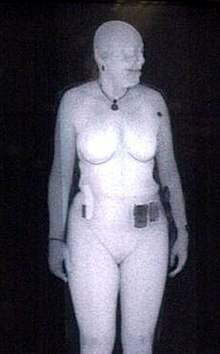Full body scanner
This article needs additional citations for verification. (September 2007) |
This article's tone or style may not reflect the encyclopedic tone used on Wikipedia. (December 2007) |

The security scan is a device to frisk a person without making physical contact.
One technology is the millimeter wave scanner, in which extremely high frequency radio waves are reflected off the body to make an image on which one can see anything hidden under the clothes. Unlike the X ray radiation used to scan luggage, this radiation is said to be harmless. Two advantages over a frisk are that it is quicker (takes only 3 seconds) and that people do not have to be touched in a manner that some might consider offensive. A disadvantage is that the scan results in an image of the naked body, albeit of low quality and the true long term health effects of this technology are unknown.
Schiphol in the Netherlands was the first airport in the world to implement this device on a large scale after a test with flight personnel the previous year. On May 15, 2007 two of 17 purchased security scans were installed. Because of the privacy issue, people are allowed to refuse this scan and opt for a traditional frisk. Also, the head is excluded from the scan and the images are instantly erased. The analyst is in a different room and can't see the person being scanned, but is in contact with other officials who can halt the scanned person if anything suspicious shows up on the scan. One security scan has been installed at Los Angeles International Airport. Another technology is the backscatter X-ray.
Manufacturers
See also
- Full-body scan (in medical imaging)
- Backscatter X-ray (for security scanning applications)
- Millimeter wave scanner (for security scanning applications)
- Puffer Machine
References
- "Innovative Security Scan simplifies passenger control". Schiphol. 2007-05-16. Retrieved 2008-12-03.
{{cite web}}: Cite has empty unknown parameters:|1=and|2=(help)
